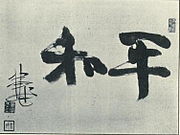Ōura Kanetake
Ōura Kanetake | |
|---|---|
大浦 兼武 | |
 Ōura Kanetake in 1910 | |
| Born | 15 June 1850 Satsuma Domain (Kagoshima Prefecture), Japan |
| Died | 30 September 1918 (aged 68) |
| Nationality | Japanese |
| Occupation(s) | politician, cabinet minister |
| Known for | "Ōura scandal" |
Viscount Ōura Kanetake (大浦 兼武, 15 June 1850 – 30 September 1918) was a politician and bureaucrat in late Meiji and early Taishō period Empire of Japan.
Early life
[edit]
The Ōura family was hereditary retainers to a branch of the Shimazu clan of Satsuma Domain. As a Satsuma samurai, Ōura Kanetaka participated in the Boshin War and the suppression of the Ōuetsu Reppan Dōmei during the Meiji Restoration. Under the new Meiji government, he joined the fledgling Japanese police force, working his way up through the ranks until he became Assistant Police Inspector of the Tokyo Metropolitan Police Department. In this capacity, he was field commander of the police forces sent to assist the fledgling Imperial Japanese Army in suppressing his fellow Satsuma countrymen in the Satsuma Rebellion.
Political career
[edit]After serving as appointed governor of Shimane Prefecture (1893–1895), Yamaguchi Prefecture (1895–1896), Kumamoto Prefecture (1896–1898) and Miyazaki Prefecture (1898), Ōura was appointed Superintendent General of the Police, and was given a seat in the House of Peers of the Diet of Japan. One of his proposals while in charge of the police was to relocate impoverished residents of central Osaka to a new planned town in the outskirts, on the theory that poverty was the cause of disease and crime. The plan failed due to strong local opposition.[1] In 1903, under the 1st Katsura administration, Ōura became Minister of Communications. He then served as Minister of Agriculture and Commerce under the 2nd Katsura cabinet and was also chairman of the Japanese committee organizing the Japan–British Exhibition.[2] In 1907, he was raised to the rank and title of danshaku (baron) under the kazoku peerage system.[3] He subsequently served as Home Minister under the 3rd Katsura cabinet and as both Minister of Agriculture and Trade and Home Minister under the 2nd Ōkuma administration. In 1911, his title was elevated to that of shishaku (viscount).
Ōura scandal
[edit]In December 1914, while in the Ōkuma administration, Ōura was accused of perpetrating voting fraud in the Diet by bribing minor political party and undecided members to influence passage of a military spending bill introduced by Ōkuma to fund two new infantry divisions for the Imperial Japanese Army. A long-time associate of Katsura, Ōura was one of the founding members and leaders of the Rikken Dōshikai political party, and used his position as Home Minister to influence the 1915 General Election in favor the party. Both issues resulted in an upsurge in public criticism from the press and opposition parties, leading to his resignation from the Cabinet in 1915.[4] This incident came to be known as the Ōura scandal.

Later life
[edit]In his final years, Ōura served as chairman of the Dai Nippon Butoku Kai.
Ōura died in 1918 at the age of 68.
Notes
[edit]- ^ McCormick, Noah (2002). Japan's Outcaste Abolition: The Struggle for National Inclusion and the Making of the Modern State. Routledge. ISBN 1136283676. page 124
- ^ Mochizuki, Kotaro. (1910) Japan To-day. A Souvenir of the Anglo-Japanese Exhibition held in London, 1910, pp. 23-25.
- ^ "Nobility, Peerage and Ranks in Ancient and Meiji-Japan," p. 24.
- ^ Scalapino, Robert A (1975). Democracy and the Party in Prewar Japan. University of California Press. ISBN 0520029143. page 206-207
References
[edit]- Dickenson, Frederick R (2001). War and National Reinvention: Japan in the Great War, 1914-1919. Harvard University Asia Center. ISBN 0674005074.
- Lebra-Chapman, Joyce. Okuma Shigenobu: statesman of Meiji Japan. Australian National University Press (1973). ISBN 0-7081-0400-2
- Mitchell, Richard (1996). Political History Bribery in Japan. University of Hawaii Press. ISBN 0824818199.
- Mochizuki, Kotarō. (1910) Japan To-day. A Souvenir of the Anglo-Japanese Exhibition held in London, 1910. Tokyo: Liberal News Agency. OCLC 5327867
- Oka Yoshitake, et al. Five Political Leaders of Modern Japan: Ito Hirobumi, Okuma Shigenobu, Hara Takashi, Inukai Tsuyoshi, and Saionji Kimmochi. University of Tokyo Press (1984). ISBN 0-86008-379-9
- Sims, Richard (2001). Japanese Political History Since the Meiji Renovation 1868-2000. Palgrave Macmillan. ISBN 0-312-23915-7.
External links
[edit]- 1850 births
- 1918 deaths
- Politicians from Kagoshima Prefecture
- Shimazu retainers
- People of the Boshin War
- People of Meiji-era Japan
- Government ministers of Japan
- Members of the House of Peers (Japan)
- Kazoku
- Ministers of home affairs of Japan
- Governors of Kumamoto Prefecture
- Rikken Dōshikai politicians
- 20th-century Japanese politicians
- Governors of Yamaguchi Prefecture
- Governors of Miyagi Prefecture
- Governors of Shimane Prefecture
- People of the Satsuma Rebellion
- Recipients of the Order of the Plum Blossom
